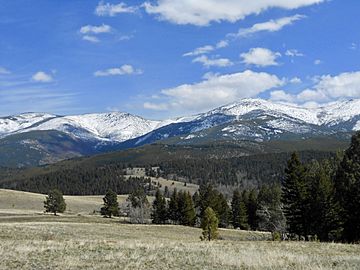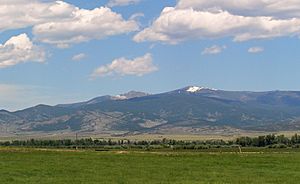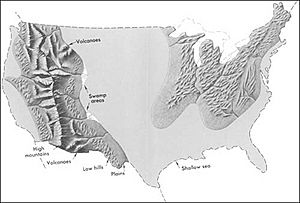Elkhorn Mountains facts for kids
Quick facts for kids Elkhorn Mountains |
|
|---|---|

West side of the Elkhorns as viewed from Jefferson County, Montana
|
|
| Highest point | |
| Peak | Crow Peak |
| Elevation | 9,414 ft (2,869 m) |
| Geography | |
| Country | United States |
| State | Montana |
| Parent range | Rocky Mountains |
| Geology | |
| Age of rock | Late Cretaceous |
The Elkhorn Mountains are a mountain range in southwestern Montana. They are part of the larger Rocky Mountains. This area covers about 300,000 acres (1200 square kilometers).
The Elkhorns are an inactive volcanic mountain range. Their highest point is Crow Peak, which stands at 9,414 feet (2,869 meters) tall. Elkhorn Peak is very close by, reaching 9,381 feet (2,859 meters).
These mountains are surrounded by several towns. These include Helena, Montana City, Townsend, Whitehall, and Boulder. The Elkhorns are also part of the Helena National Forest in Jefferson County, Montana.
Contents
How the Elkhorn Mountains Formed
The rocks that make up the Elkhorn Mountains were created a long time ago. This happened about 74 to 81 million years ago, during the Late Cretaceous period. At that time, a large piece of Earth's crust, called the Farallon tectonic plate, was sliding under western North America.
Volcanic Activity and Rock Formation
When the Farallon plate slid down, it caused hot, melted rock called magma to rise to the surface. This magma then erupted as volcanoes. The rocks from these eruptions are called Elkhorn Mountains Volcanics. They are extrusive rocks, meaning they formed when lava cooled on the surface.
These volcanic rocks are linked to deeper, plutonic rocks. Plutonic rocks are like the granites found in the Boulder Batholith. They form when magma cools slowly underground.
Spreading Volcanic Material
Volcanic flows, mudslides (called lahars), and ash falls from the Elkhorn Mountains spread far and wide. They reached as far as Choteau, Montana. However, the thickest layers of these materials are found within about 60 miles (97 kilometers) of the Elkhorns. Scientists believe these volcanic materials once covered an area of about 10,000 square miles (26,000 square kilometers).
Minerals and Mountain Uplift
Many valuable minerals are found in the Elkhorn Mountains Volcanics. For example, minerals were mined at Elkhorn, Montana, which is now a ghost town. Gold was also found at the Golden Sunlight Mine near Whitehall. This gold is connected to a special rock formation within the volcanic rocks.
The mountain range we see today was lifted up much later. This major uplift happened mostly during the Oligocene time period.
The Land and Its Wildlife

In 1988, a large forest fire burned 47,000 acres (190 square kilometers) of the Elkhorn Mountains. After the fire, many new lodgepole pine trees began to grow. Today, you can see large areas of young forests.
Past Uses and Their Impact
In the past, people used the land in the Elkhorns for many things. They mined for gold and silver, cut down trees for logging, and let livestock graze freely. These activities left a clear mark on the land. One of the most noticeable impacts is the abandoned mining town of Elkhorn.
Protecting the Elkhorn Mountains
Recently, several groups have worked together to protect the Elkhorns. These include the BLM, Montana Fish, Wildlife & Parks (FWP), and the Helena National Forest. They have created new plans to help conserve the land and manage wildlife.
Some of these plans include bringing back bighorn sheep to the area. They also have a program to restore the westslope cutthroat trout. Managing the large herd of over 2,000 elk in the area is also an ongoing task. Another important job is stopping the spread of harmful plants called noxious weeds.
Roadless Areas and Biodiversity
Even with past mining and logging, about 100,000 acres of the Elkhorns were still without roads in 1992. This included large areas of National Forest land, plus nearby lands owned by the BLM, the state, and private groups.
Congress has set aside 175,000 acres of the range as the "Elkhorns Wildlife Management Area." This area is home to one of Montana's most successful elk herds. The Elkhorns are also higher than the nearby Continental Divide. This means they get more rain and snow than most other ranges east of the Divide. Because of this extra moisture, the Elkhorns are very diverse. They are home to 148 different kinds of animals with backbones.



